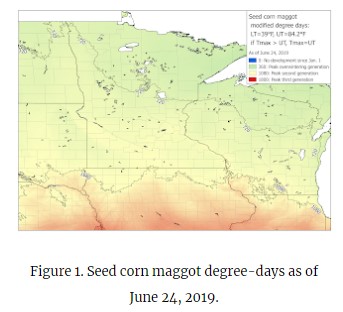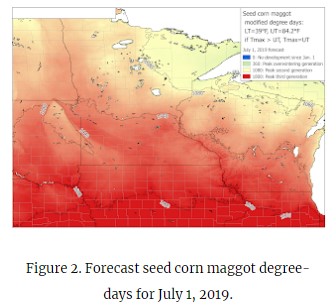By Anthony Hanson
With delayed planting and growers considering alternatives on prevented plant corn and soybean ground, crops planted in late June this year run the risk of infestation by seed corn maggot.
Seed corn maggot (SCM) feeds on newly emerging seedlings where females lay eggs in disturbed soil beginning in spring, and multiple generations continue throughout the growing season. Infestations are common in cool wet springs and areas with high organic matter (e.g, manure or recently incorporated plant material). Corn and soybeans are the most economically affected crops, but SCM has a wide host range on various agronomic and horticultural crops.
Damage is most likely in fields planted during the population peak for each generation, which can be predicted by calculating degree-days specific to SCM. As of June 24, 2019, the second generation peak at 1080 degree-days is occuring at the southern Minnesota border and will progress northward across most of Minnesota within the week (Figs. 1 and 2).


Degree-day maps only indicate the time of year when high risk can occur and do not guarantee individual fields will have issues. Fields with historical SCM problems or high organic matter should be considered for additional management if they are being planted this week. This year, the timing occurs when many growers are now considering planting cover crops or forage on prevented plant acres that may be harvested after September 1 for hay or grazing.
After planting, there are no effective treatments once damage occurs, though there are some insecticides labeled for in-furrow or seed-applied use at planting. Planting can also be delayed in high-risk fields until after June this year to avoid peak seedcorn maggot flight; this decision also needs to be balanced with already delayed planting and if it’s ecomically feasible to wait another week depending on the growing needs of the crop. Some forage crops can be planted in to July, which can avoid the high-risk window.
Source: umn.edu